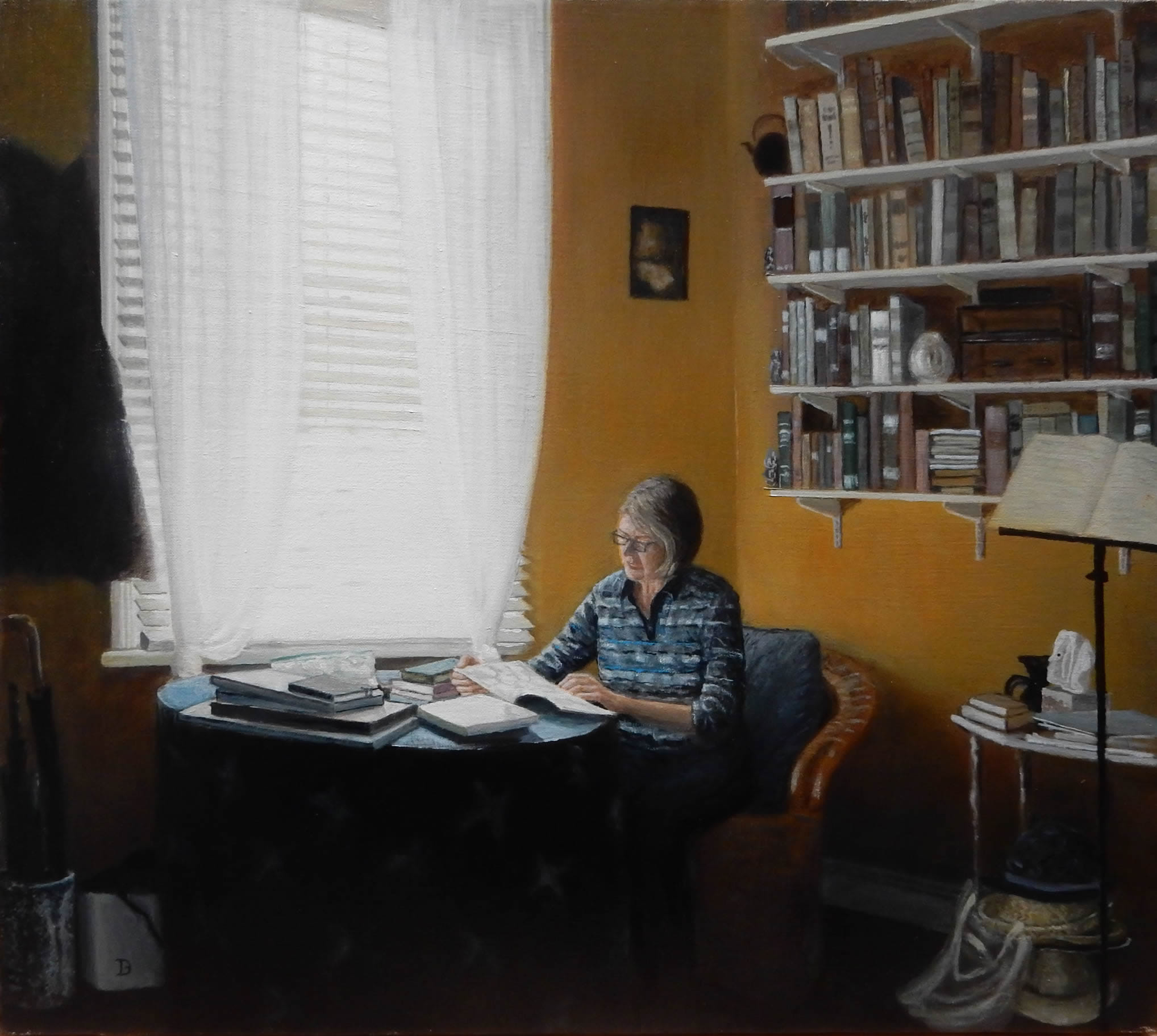Conversation IV
Or, talking books, art and life with author Duncan Ball.

Back in the 80s, my family had a subscription to the Family Circle magazine and – as soon as I could get my hands on it – I would turn to the kids’ section and find out what my hero, Selby the Talking Dog, had been up to. Imagine my delight when, in the early 2000s, I got to work with Duncan Ball, Selby’s creator, in my role as a Content Producer at HarperCollins.
I’m blessed to have Duncan and his wonderful wife Jill as my friends. It’s so exciting to share Duncan’s insights with you in this post, along with a small sample of his new creative endeavours as he returns to the call of the canvas in his retirement.
I hope you enjoy reading about books, art and life with this dear colleague and true gentleman.

-----------------

Hi Duncan, thank you so much for taking some time to talk to me for the blog.
You started your career as an industrial chemist, but you quit that to work as the editor of the School Magazine of the Department of Education of New South Wales. That’s quite a leap! Can you please tell us how you managed to make that happen and how this new career direction laid the foundation of your writing practice?
I was rudderless as a teenager. I was interested in painting and in writing, but I didn’t think there was a living for me in either. I spent a year after high school studying Civil Engineering, didn’t like it, went to Paris and studied French language and culture for a year. When my savings ran out, I returned to my hometown of Boston, Massachusetts, and started studying Chemistry and Mathematics. When I finally graduated, I worked in chemical research. That’s what I was working at when I moved to Australia in 1974.
Much as I liked the work and the wonderful group of people I worked with here, I still wanted to do something in the arts. I’d written a novel for adults while I was working as a chemist and, as luck would have it, it was published. While it was not a happy publishing experience it gave me encouragement to continue writing and even to try to make a living from it.
I saw an ad in the newspaper for the Assistant to the Editor of The School Magazine at the NSW Department of Education. I applied and, by some miracle, got it. The editor was Lilith Norman who had written a few children’s books. Soon she retired and I replaced her.
During the four and a half years I was the editor of The School Magazine I read hundreds of kids’ books and even wrote one myself as well as writing and editing articles for the magazine. My first children’s novel, The Ghost and the Goggle Box, was published while I was still working for the magazine and I wrote two sequels before I threw caution to the wind and quit my job to be a freelance author.

I had the great fortune of working with you when you were promoting the Selby books – the classic stories about Australia’s favourite talking dog. Can you please tell us how this delightful character came about?
And it was my good fortune to work with you! Selby began as a serial for the children’s pages of Family Circle Magazine. A friend told me that the editor was looking for a series of kids' stories to fill a page of the magazine every month. The space was small, about 850 words. Fitting a whole story with a beginning, middle and end would be tricky. I knew I had to concentrate on one character and that the character had to be one that young readers would easily relate to. I chose a dog and named him Selby. Fictional characters have to have something about them that’s unique and they need motivation. I decided that Selby had somehow – perhaps by magic – learned to talk. Initially, he was going to talk to his loving owners, Dr and Mrs Trifle. But at the last minute, he suddenly thought that, if they knew he could talk, sooner or later he’d be asked to do things around the house such as washing dishes. So he decided to keep his ability to talk – and read and write – a secret even if it killed him. In the Selby stories, he often faces a dilemma that (almost) forces him to give away his secret.
In total there were 208 Selby stories, published in 16 collections, along with other spin-offs such as two Selby joke books. Of course, they wouldn’t have been the same without Allan Stomann’s wonderful illustrations.
I’d love to know what your writing process was. Did you have to chain yourself to the desk to make it happen, was it a joy or a chore?
As with most artistic endeavours it was a joy when it went well and a chore when it didn’t. Paring down a story to the most economical length and coming up with the surprise twists and turns of stories like this isn’t easy. I spent a lot of my writing time chained to my desk and with an editor pushing me to finish that last story for another book. Easy reading is very hard writing. There was always a point where I knew I’d nailed the story and it was just a matter of going back over it to make sure that everything was ‘set up’ to give it the strongest possible ending. When it worked, it was bliss.
I spent years visiting schools all around Australia and even overseas reading my stories aloud to kids – not just reading them but performing them complete with whispers, shouts and screams. The satisfaction of delighting kids with my stories and, hopefully, to encourage them to read was a joy in itself.
In addition to Selby, you’ve developed lots of other characters too – can you please tell us about some of your favourites?
Running second in popularity to Selby is Emily Eyefinger. The Emily Eyefinger series (illustrated by Craig Smith) is about a little girl who was born with an eye on the end of her finger. These stories are intended for a lower reading and interest age than the Selby stories. As with the Selby books, these are anthologies of short stories each with an ‘adventure’ in which Emily saves the day because she has the unique ability to see with her finger. Of course, it’s also a disability because there are things, like playing most musical instruments, that she will never be able to do.
Another favourite character of mine is Bert Piggott, the only sensible member of the mad and sometimes dodgy Piggott family. The first book is Piggott Place and the second, Piggotts in Peril. They were intended as the start of another series.
I wrote six picture books including Jeremy’s Tail and My Dog’s a Scaredy-Cat. I’ve written 75 or 80 books in all, including four books written in collaboration with another author using the pseudonym, John St Clair.
Two of my favourites are my collection of funny poetry, My Sister has a Big Black Beard, and a collection of short plays and sketches called This School is Driving Me Nuts! A few of those plays have been performed in schools. A high school in northern Saskatchewan of Canadian First Nations kids performed three of them to much acclaim. I’d like to think that I’m the only Australian author who has had a play translated into the Cree First Nations language. Correct me if I’m wrong.

There’s something special about the step that children take when their imaginations are engaged and they start reading for pleasure. It must be so wonderful to know that you’ve contributed to that spark in so many lives. Can you please tell us what responsibility the author has in that journey and any personal experiences that you have about helping kids love to read?
I was a very reluctant reader as a kid. I was virtually a non-reader until I was in my teens. But, having been read to when I was very young, I knew that the right books were filled with excitement. If I’d been a good reader as a kid, I think I would have turned into a very different writer. I’ve tried my best to fill my books with high-interest subject matter and as much emotion as I can. I use a lot of humour and kids love humour.
Over the years I’ve been writing for kids I’ve had thousands of fan letters and emails but nothing has been more gratifying than receiving mail from parents or from adults who read my books when they were young saying that, without my stories, they never would have learned to read. Of course, they would have but it’s wonderful to hear that my work has helped.
These days, you’re dabbling in painting – a creative pursuit that you’ve always enjoyed. Can you please tell us about your art and where you’d like to take it?
I’ve always loved paintings. In my teens, I lived in Madrid, later in Paris, and my hometown is Boston, Massachusetts. All of these cities have wonderful art museums and from them came the inspiration to paint. Recently I’ve been painting realistic paintings but, in the past, my work has ranged from abstract to fantasy. It’s a joy to have the time to just play around with it and see where it takes me.
-----------------
You can read more about Duncan and find his books on his website at www.duncanball.com.au
